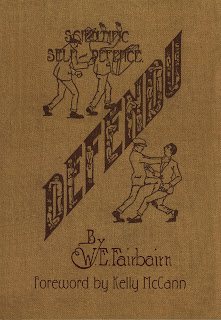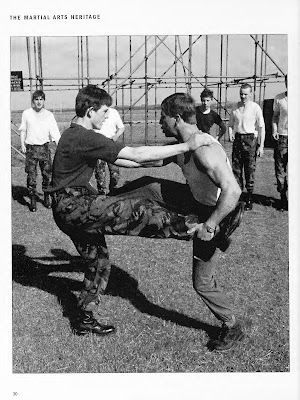January 2023 Book Survey Part 2
Welcome to the January 2023 book survey, part two. I decided to break this month's survey into three posts. This is the second. In the last post I looked at Krav Maga. Next time I will look at mixed martial arts.
Introduction
In January 2023, I (Richard) continued my reading plan. This post looks at combatives.
The Shanghai School of Streetfighting, Tommy Joe Moore, 2020
I bought The Shanghai School of Streetfighting because I was a fan of the author's previous book on Bartitsu, surveyed in February 2022. My copy of this book is a 8 1/4 inches by 5 13/16 inches color paperback with 342 pages. The content is based on the work of W. E. Fairbairn (1885-1960).
I just love this book. The quality and presentation is similar to Mr. Moore's previous title. The photographs are superb, with period clothing and settings. It's a real work of art. Here's a sample:
I highly recommend this book.
American Arwrology: The Science of All-Out Hand-to-Hand Fighting, Fred C. Bauer, 2013
My copy of American Arwrology is a 6 inches by 9 inches paperback with 128 black and white pages, 14 of which are blank. The book wastes a lot of space. It looks like it was sized for a smaller page. Here is an example:
I measured 1 1/4 inches of blank space at the top and bottom of the pages of my paperback copy. Here is an example of the small photos on a largely blank page:
It seems that with the blank space removed, this title becomes more of a booklet.
The author claims that the preface, introduction, and "most of chapter 2" are the words of the late Robert Kasper (1950-2006). The rest is based on Mr. Kasper's notes and outline, articulated by Mr. Bauer. This is odd -- why isn't Mr. Kasper listed as a co-author, then?
The book itself is an interpretation of the "Arwology" style created by Gordon E. Perrigard (1915-2000), as published in his 1943 book. The authors state that Mr. Perrigard "had been a student of Samurai Jiu-Jitsu for 23 years" in 1943 (when the book was published), meaning he apparently began so-called samurai training at age 5 -- as a Canadian?
This book isn't a bad way to learn more about Arwology, but if it were reformatted there wouldn't be much beyond a lengthy article. It's definitely not worth a $20 cover price.
Defendu, W. E. Fairbairn, Kelly McCann, 1926/2007
The book offers techniques like the following:
This book is a great snapshot of combatives techniques as taught in the 1920s. The jiujitsu influence is clear.
Survival on the Battlefield, Robert K. Spear, 1987
My copy of Survival on the Battlefield is a large 10 13/16 inches by 8 3/8 inches black and white paperback with 186 pages. This book is on the larger side for Unique Publications. The back cover is comical:
The author was a 5th degree black belt in Hapkido at the time. He earned his 3rd degree in Hapkido in 1975 in South Korea. He seeks to address weaknesses in Army combatives, which were a serious problem at the time of publication.
He aims the book squarely at Army leaders, with a whole program for revising combatives. The Army did not adopt it, as we will see shortly.
The Elite Forces Handbook of Unarmed Combat, Ron Shillingford, 2000
My copy of The Elite Forces Handbook of Unarmed Combat is a 7 1/2 inches by 9 1/2 inches black and white paperback with 192 pages. There is a digital copy available for borrowing from the Internet Archive. The author is neither a soldier nor a martial artist. He is a writer covering boxing and martial arts.
The book surveys combatives techniques from the Russian Spetznaz, Egyptian special forces, the US Army, and the UK Parachute Regiment. It starts by repeating common myths and falsehoods about ancient Chinese and Indian martial arts, but it then cites the European Flowers of Battle book surveyed in December 2022. Aside from that bright spot, there are more wasted words on so-called "Russian Martial Art... several millenia before the birth of Christ to roughly the 6th century AD" (p 21) and more in a "Martial Arts Heritage" chapter.
It's a shame this book has so many worthless words, as the photos and diagrams are pretty great. Here's a sample:
In brief, there's quite a lot here, but the author is just not credible.
H2H: Hand to Hand Combat - Modern Army Combatives, Greg Thompson, Kid Peligro, 2006
Thankfully we can end this survey on a strong note. My copy of H2H: Hand to Hand Combat - Modern Army Combatives is a large 8 1/2 inches by 10 1/2 inches color paperback with 256 pages published by Invisible Cities press. The cover probably has the happiest martial artist I've ever seen, showing Greg Thompson, a teacher of modern Army combatives at Fort Bragg. Mr. Thompson at the time of writing was a Gracie jiu-jitsu black belt, a karate black belt, and a Muay Thai Kru.
The foreword by the father of modern Army combatives, Matt Larson, provides context. Mr. Larson says the style was derived from hundreds of interviews with troops who fought in south-west Asia. He notes that "every hand-to-hand fight we have documented has involved grappling, but not a single one has involved only striking... [and] around 30% of the fights ended with gunshots" (p 9).
The book features over 120 unarmed techniques. It's a gorgeous book with with a great layout that makes solid use of each page.
Note that the 2012 H2H Combat Soldiers Edition add techniques 129-150, plus a bit of material at the front and back of the book.
Also, Mr. Larsen published his own Modern Army Combatives book in 2013, which I may survey in the future.
Conclusion
My favorite title in this collection is The Shanghai School of Streetfighting by Tommy Joe Moore. I also like the combatives book by Greg Thompson, although finding a copy can become a somewhat pricey experience.
You may know about our Amazon Wish List. If you would like to help us get books to read and review from that list, then please consider supporting us via Buy Me a Coffee.
If you like this article, check out our Facebook page, Instagram account, Twitter feed, and Amazon Wish List. Be devoted!






















Comments
Post a Comment